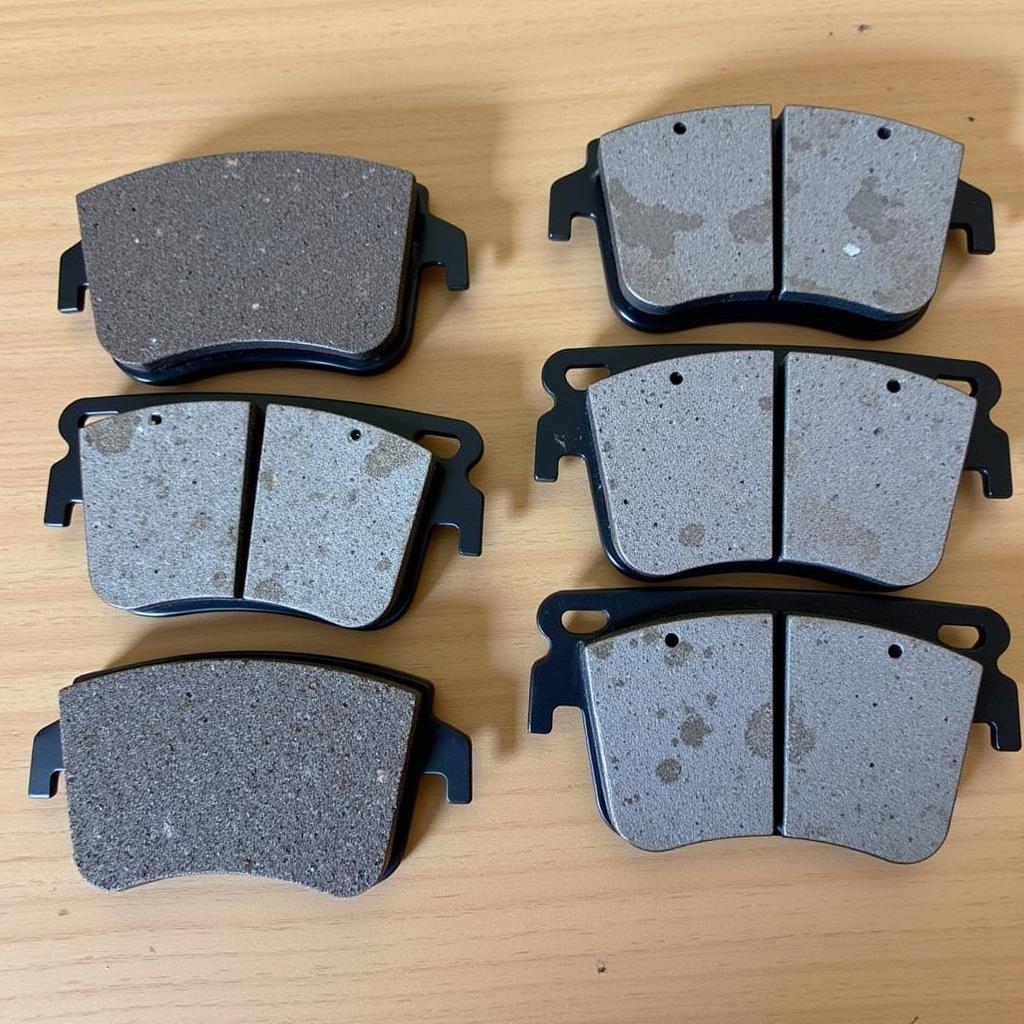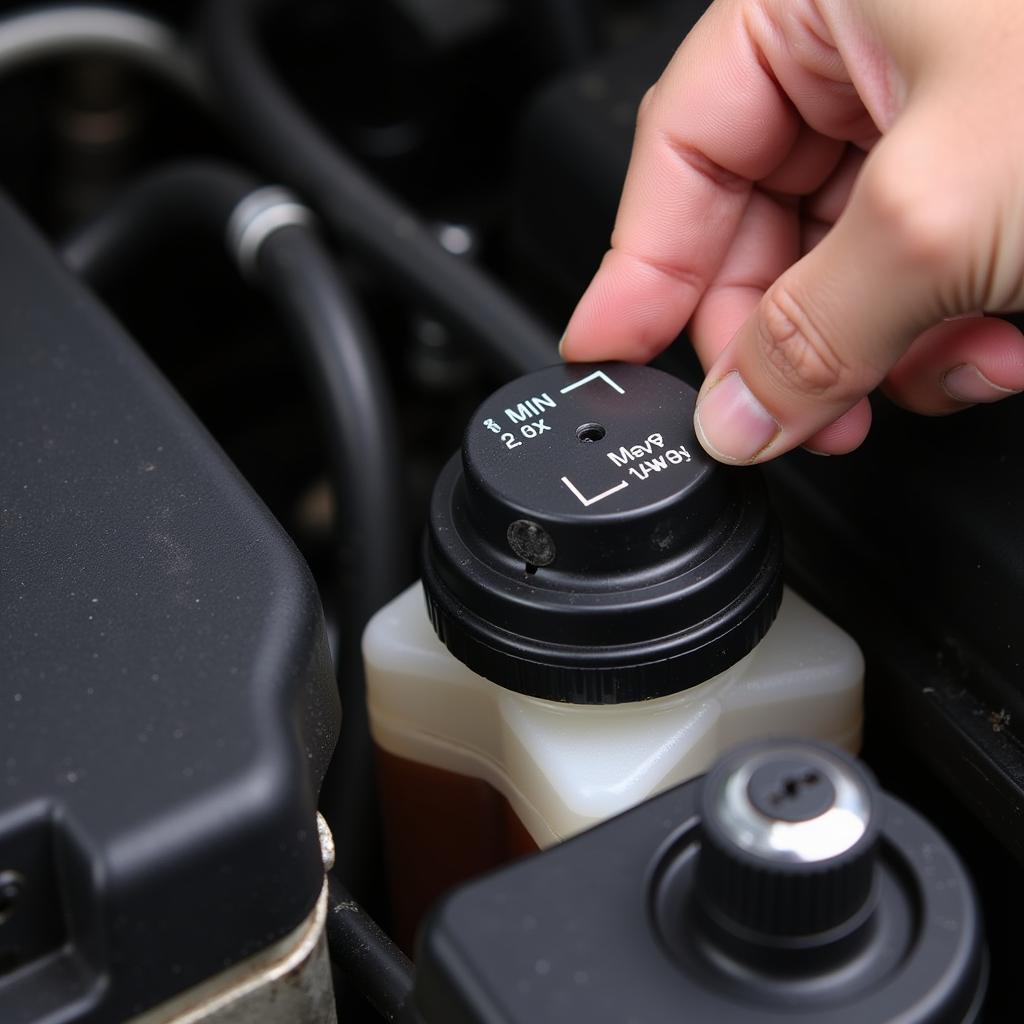The brake warning light on your 2002 Dodge Durango is a crucial safety feature that shouldn’t be ignored. It’s designed to alert you to potential issues within your braking system, from low brake fluid to more serious problems. This comprehensive guide will help you diagnose the root cause of a lit brake warning light on your Durango and provide potential solutions to get you back on the road safely.
While this guide provides valuable information, always remember that safety comes first. If you’re unsure about any step of the diagnostic process or lack the necessary tools and experience, it’s best to consult a qualified mechanic specializing in Dodge vehicles.
Common Causes of a 2002 Dodge Durango Brake Warning Light
Let’s delve into the common culprits behind a glowing brake warning light on your Durango:
1. Low Brake Fluid
What it Means: Your Durango’s braking system relies on hydraulic pressure, created by brake fluid, to function correctly. A drop in brake fluid level usually indicates a leak within the system.
How to Check:
- Locate the brake fluid reservoir under the hood. It’s a translucent plastic container with a black cap labeled “Brake Fluid.”
- Check the fluid level. The reservoir has “Min” and “Max” markings. If the level is below “Min,” you have low brake fluid.
What to Do:
- Address Leaks: If you suspect a leak, carefully inspect all brake lines, hoses, and connections for signs of wetness or dripping. A leak requires immediate attention from a qualified mechanic.
- Top Up Brake Fluid: If you don’t see any leaks and the fluid level is slightly low, carefully top it up with DOT 3 brake fluid, ensuring you use the correct fluid type specified in your owner’s manual.
 2002 Dodge Durango Brake Fluid Reservoir
2002 Dodge Durango Brake Fluid Reservoir
2. Worn Brake Pads
What it Means: Brake pads are designed to wear down over time. When they reach a certain thickness, a small metal tab on the pad makes contact with the rotor, triggering the brake warning light.
How to Check:
- Look through the spaces between your wheel’s spokes to inspect the brake pads.
- You’ll see a metal backing plate and the friction material of the brake pad.
- If the friction material is less than ¼ inch thick, it’s time for new brake pads.
What to Do:
- Replace Brake Pads: Worn brake pads need immediate replacement to ensure safe braking. It’s best to have a professional mechanic perform this task.
 Worn Brake Pads on a 2002 Dodge Durango
Worn Brake Pads on a 2002 Dodge Durango
3. Faulty Brake Caliper
What it Means: The brake caliper houses the piston that pushes the brake pads against the rotor. A sticking caliper can cause uneven pad wear, dragging brakes, and potentially trigger the warning light.
How to Check:
- Uneven Wear: Check for uneven wear patterns on your brake pads. One pad wearing down faster than the other on the same axle can indicate a caliper issue.
- Dragging Brakes: Drive your Durango slowly and listen for any scraping or grinding sounds. If you feel resistance or the vehicle pulls to one side, it could be a sign of a sticking caliper.
What to Do:
- Repair or Replace Caliper: Diagnosing and repairing a brake caliper requires specialized tools and knowledge. Seek professional help to address this issue.
4. ABS Issues
What it Means: Your Durango’s Anti-lock Braking System (ABS) is a safety feature that prevents wheel lockup during hard braking. If the ABS module or a wheel speed sensor malfunctions, the system might illuminate the brake warning light.
How to Check:
- ABS Light: If the ABS warning light is also illuminated on your dashboard, it indicates a potential problem within the ABS system.
What to Do:
- Diagnostic Scan: A professional mechanic can connect a diagnostic scanner to your Durango’s OBD-II port to retrieve error codes related to the ABS system and pinpoint the problem.
“A common misconception is that a lit brake warning light always means immediate danger. While it’s crucial to address the issue promptly, a glowing light doesn’t necessarily equate to complete brake failure. However, it’s always best to err on the side of caution and have your vehicle inspected by a professional as soon as possible.” – John Miller, ASE Certified Master Technician
5. Electrical Malfunctions
What it Means: Like any electrical system, the wiring and sensors associated with your Durango’s braking system are susceptible to damage and corrosion.
How to Check:
- Visual Inspection: Check for any loose connections, damaged wiring, or corroded terminals around the brake fluid reservoir, master cylinder, and ABS module.
What to Do:
- Repair or Replace Components: Address any electrical issues promptly. Seek professional help for a thorough inspection and repair.
 Brake Light Switch on a 2002 Dodge Durango
Brake Light Switch on a 2002 Dodge Durango
Conclusion
The brake warning light on your 2002 Dodge Durango is an essential safety feature. While it might seem intimidating, understanding the common causes can help you take the right steps to address the issue promptly and safely. Remember, when it comes to brakes, it’s always better to err on the side of caution. If you’re unsure about any aspect of diagnosing or repairing your Durango’s braking system, don’t hesitate to seek assistance from a qualified mechanic specializing in Dodge vehicles.

